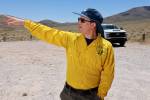Family business supplies farm-fresh greens to local chefs, markets
Brett Runion is a programmer for a gaming company. But his roots are in Iowa, and two years ago he traveled there to take a look at his grandparents’ old farmhouse. He had read his grandfather’s biography and learned a lot about the life of a farmer, impressed with “how hard they worked.”
He was inspired, and when he returned to Las Vegas and sat down with his family to discuss a business in which they could all take part, he decided it would be a growth industry, literally and figuratively.
Runion and his daughters (he also has two sons, but they’re a little young) launched R Fish &Veggies late last summer. The R is for Runion, both the business’ reason for being and its means of survival.
“My biggest asset is my kids,” he said. “It’s been wonderful, because my daughters are uniquely gifted.”
He left the decision on whether to form the business up to them, because it was going to be a lot of work. And Dad, at least for the time being, has a day job.
They decided on farming, but it would be hydroponic farming, in which the plants are grown in water.
“There’s not much you can do here” in terms of conventional agriculture, Runion said. Indoor farming is far more feasible because the environment can be tightly controlled, which affects not only yield but also flavor and overall quality. And the technology behind it, he said, has advanced greatly.
The “veggie” part of the business’ name refers, of course, to the vegetables they grow.
The “fish” was intended to refer to tilapia; the plants, at least theoretically, would grow on the nutrients from the filtered fish waste. But Runion knew that getting the correct ratio of fish to plants — and plants to fish — was daunting and potentially extremely expensive, so he decided to focus initially on veggies and add the fish part of the operation later.
Right now, three of his five daughters are involved in the business. Anne Elizabeth, a graduate of the University of Nevada, Las Vegas, is second in command and sales and operations manager, handling the technical part of the business and pretty much anything a chief cook and bottle-washer would do. Eliza, who recently graduated from high school, handles seeding and harvesting with the assistance of Anne. And Rebekah, who recently moved to Montana, does the books, online.
They currently produce several varieties of kale — “because it’s so popular now,” Anne said — plus spring mixes, saute mixes, microgreens and petite greens. Currently, they sell to Whole Foods Market, with their products available in the company’s four stores in the valley. Their kale and microgreens also are served by one of the Go Raw restaurants in the valley.
R Fish &Veggies’ first customer was chef Wes Kendrick at Table 34 restaurant, who, Runion said, was an early source of support.
“It would not have been possible without him,” he said. “He really has helped us.”
Kendrick said he’s happy with the products.
“They’re doing a variety of kale for me,” he said, with tatsoi and spicy mustard mixed in.
“It’s just awesome stuff,” he said. “Really tender, really nice, always fresh.
“I also started using some of their hydroponic sprouts. They come in living, which is awesome, because I can keep them. The shelf life is wonderful.”
He said he uses a variety of sprouts: “They’re doing a little spicy mix for me,” as well as radish, kohlrabi and broccoli sprouts.
“The microbasil that they do is a nice touch, too,” Kendrick said. “We’re getting into the season where I can run heirloom tomatoes, so it’s a really nice addition to the dish.”
Kendrick said he wasn’t nervous about working with a startup company.
“I saw the product, so I was fairly confident on the operation,” he said. “After talking to them and their willingness to kind of explore different options to create different mixes for different chefs, I felt a little better about it.”
Brett Runion said the shelf life of his kale runs about two weeks, far more than the conventional product available in supermarkets.
“Everything comes from out of town,” he said. That means it has to be picked and processed and packaged and trucked, requiring several days just to get to Las Vegas.
R Fish &Veggies’ kale, he said, doesn’t have to be massaged before it’s used raw, and the center rib doesn’t have to be cut out. It’s not only fresher than most commercially available kale but also younger, and the closely controlled nutrients affect the quality.
“You can use it in a sandwich like lettuce,” Runion said, and indeed, a fresh-plucked leaf of kale was crunchy and very tender. (Kale will be the subject of next week’s lead Taste story, with recipes.)
They wear gloves for every step of production.
“Nobody touches your food until you touch it,” Runion said.
“Food safety’s very important,” added Anne Runion.
They have 13,000 square feet in an industrial park in the northeast part of the valley, with 9,000 square feet currently under production. Most of the plants grow in long tubular structures, stacked on palette racks.
The microgreens, which are seedlings, are grown in trays, using a flood-and-drain system. There’s a nursery for young plants and germinating seeds. Foggers control humidity, and water is filtered through a reverse-osmosis system.
Because of the way the plants are stacked, Runion said, they can get 4 acres of growing space into 13,000 square feet.
“It uses less water than a family of four,” Runion said. “The water bill here is lower than my bill at home.”
He did the design work and research, and put the whole thing together with the assistance of his daughters, a son-in-law and a friend. The process, Anne Runion said, often evoked memories of her childhood hikes with her father, who always promised that the end of the trail was right over the next hill. When she built a vent for the lighting system, she said, her father praised the work, and then said, “Now I just need 117 more.”
“That happened a couple of times,” she said. “I was ready.”
They continue to experiment with plant varieties, developing their markets and, eventually, adding the fish operation.
For his part, Kendrick seems to be glad.
“I think it’s just neat,” he said, “that there’s actually somebody in the valley trying to do stuff like that, so I want to support them as much as I can.”
Contact reporter Heidi Knapp Rinella at hrinella@reviewjournal.com or 702-383-0474.

































